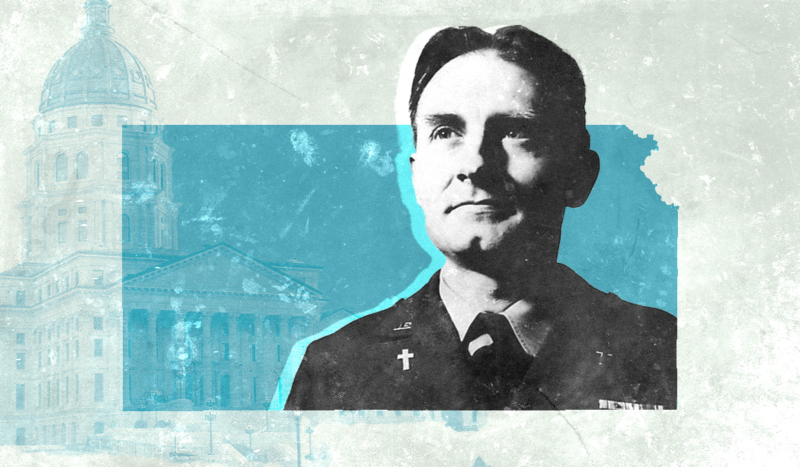
CV NEWS FEED // A Kansas state senator recently introduced legislation to place a statue of the Servant of God and heroic military chaplain Fr. Emil Kapaun in the KS State Capitol building.
Senator Chase Blasi (R, Wichita) an alumnus of the Catholic school Newman University, introduced the bill on January 31. The statue is to be privately funded. The Kansas Senate Federal and State Affairs Committee is set to begin reviewing the legislation on February 14.
The Kansas Catholic Conference will be at the hearing to testify to the exemplary life of Kapaun. Executive Director of the KCC Chuck Weber told CatholicVote that much of the inspiration to put a statue of Kapaun in the capitol “stemmed from a desire to provide a much needed positive role model for Kansans and others to reflect upon.”
“Politics is a reflection of our culture today and it can often become very heated and negative. Father Kapaun is an uplifting example of what we ought to strive for as we seek the common good,” Weber said:
Father Kapaun was shaped by his farming upbringing in the community of Pilsen on the plains of Kansas. Modest in demeanor and financial means, nevertheless, he was possessed of deep reserves of character: he was hard-working, ingenious, neighborly, resilient and full of good cheer.
“Greatest of all were his faith and love of his neighbor, which caused him to answer the call not only to the priesthood, but also to the service of his country,” Weber said. “Nurtured by the rich soil of faith and hard work, he went on to become a national hero and the most decorated chaplain in military history.”
Kapaun was born in 1916 in Kansas. He was ordained a priest in 1940 and several years later was assigned to serve as auxiliary chaplain at the Army air base in Herington, Kansas. The Fr. Kapaun website reads, “It was here that Father Kapaun felt he was called to ‘spend himself for God’, and after several requests, his bishop allowed him to enter the U.S. Army Chaplain Corps on July 12, 1944.”
“Kapaun was shipped out to Yokohama, Japan in January of 1950 to join the post-World War II peacekeeping forces of the 1st Cavalry Division stationed there. Father Kapaun performed regular religious duties for the troops and even joined them for military maneuvers,” the website states.
On June 25, 1950, communist North Korea invaded South Korea. Kapaun and his unit were shortly after sent to South Korea to help there. “During the next four months, Chaplain Kapaun tended to his chaplaincy duties with fierce devotion,” the website states:
…He quickly earned a reputation for being a fearless soldier who risked his life to minister to the men fighting on the front lines. Along with praying with men in foxholes and saying Mass on the battlefield (oftentimes using the hood of his Jeep as the altar), Chaplain Kapaun would risk his life to administer the sacraments to the dying, to retrieve wounded soldiers, and to bury the dead – ally and enemy alike.
On November 1 in 1950, Communist forces attacked Kapaun’s unit. Kapaun had the opportunity to flee and save his own life, but he chose to stay behind and minister to the dying soldiers.
Kapaun and his unit were taken as prisoners of war on November 2 and taken to a prisoner camp in Pyoktong, North Korea. Kapaun survived seven months in this camp, where he heroically cared for the other prisoners of war, both spiritually and physically.
Prayer in the camp was forbidden, yet Kapaun led his soldiers in prayer for their captors and for themselves. He also volunteered to bury the dead so he could pray over their graves in secret.
“With his selfless acts and indomitable spirit, he gave the other prisoners hope despite the tortures they experienced,” the website states. “His Chinese captors considered him to be an agitator and a propagandist, but their attempts to scare, threaten and humiliate him failed. They were afraid to eliminate him or stop him for fear the other prisoners would start a rebellion.”
In 1951, at age 35, Kapaun died from pneumonia and blood clotting at the prisoner camp in North Korea after intense service to those around him. Just before he died, he told the other prisoners of war, who loved him deeply: “Don’t worry about me. I’m going where I always wanted to go, and when I get there, I’ll say a prayer for all of you.”
Pope John Paul II named Kapaun a Servant of God in 1993, advancing his path to being declared a saint.
Reflecting on what Kapaun’s statue in the Kansas state capitol would signify for Kansas legislators and citizens, Chuck Weber said, “The State motto of Kansas is ‘Ad astra per aspera’, Latin for: ‘To the stars through difficulties.’ Chaplain Father Kapaun’s life story reflects this motto well.”
“He had the courage not to seek the easy way out, but to brave bullets and bombs on the battlefield, as well as facing communist threats and indoctrination in a North Korean prison camp,” Weber continued:
In the darkest of times he stepped up and sacrificed himself for his fellow prisoners of war, giving them the hope to live and providing them a sense of peace which could only come from God. There is a great need for these virtues today, as well as the courage to face criticism or threats for the sake of what is true and good.
“We are always asking for prayers for the advancement of Father Kapaun’s cause for sainthood. We love to send prayer cards and informational booklets out,” Weber said. “If anyone would like to request these or learn more, they can visit www.frkapaun.org.”

